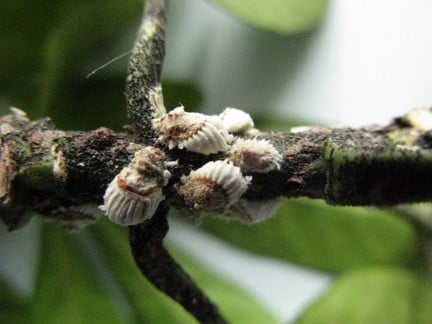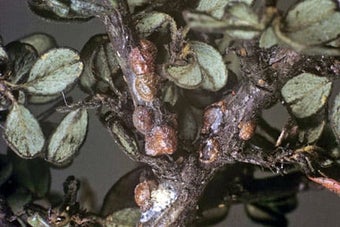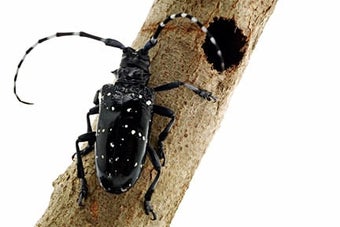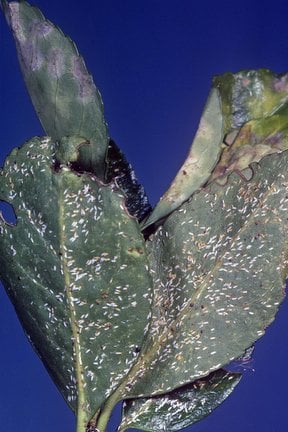
Quick facts
Common name - Fluted scale
Scientific name - Icerya purchasi
Plants affected - Citrus, Acacia, Choisya and many other mainly woody plants
Main cause - A sap-sucking insect
Timing - Present all year round
What is fluted scale?
Fluted scale is a -sucking insect that originates from Australasia but has become widespread in the warmer parts of the world, including the Mediterranean area. It is also sometimes known as cottony cushion scale, but should not be confused with cushion scale or woolly vine/currant scale. It was an uncommon insect in heated glasshouses in Britain but since the 1990s it has become established outside in sheltered places, especially in London.
Scale insects are sap sucking true bugs belonging to several families in the Hemiptera. Typically the adults are immobile having a flattened or raised appearance, with no visible legs. They often look like a ‘scale’ on a leaf or stem, many species produce a white wax often covering egg masses. There are more than 100 species found in Britain, 26 of which have been introduced. More than 25 species can be found in gardens or on houseplants.
Symptoms
The adult flutted scales are flat, oval insects, 4-5 mm long and reddish brown in colour. The females are usually found perched on the edge of white waxy mounds in which eggs are deposited. These egg mounds have a distinctive grooved or fluted appearance, which is unlike any other scale species found in the UK. The young nymphs are oval and brownish but have a white waxy coating. Adults and nymphs can be found together all year round on the stems and foliage. Frequent host plants are Citrus, Acacia and Choisya but it can occur on many other woody plants.
Fluted scale sucks from a wide range of trees and shrubs. Heavily affected plants lack vigour and can be killed. A black sooty mould may grow on the insect's sugary honeydew excrement.
Management
If you encounter this insect on indoor plants then please consult our page on indoor plants: sap feeders for indoor specific advice.
- When buying Citrus, Acacia or Choisya, check carefully to make sure they are free of fluted scale
- Where possible tolerate populations of scale insects. Well-tended healthy plants are able to tolerate light populations of these insects and so they do not necessarily require management
- Encourage predators in the garden; some ladybirds, parasitoid wasps and some birds will eat scale insects. In many parts of the world, an Australian ladybird known as the vedalia ladybird, Rodolia cardinalis, has been released as a biological control for fluted scale. This ladybird is not commercially available in Britain but it has been found in some parts of London. It probably arrived accidentally, along with the scale insect, on imported plants
- Adult scales and egg masses can be removed when seen but this may not reduce large populations
Biology
Fluted scale has two or three generations a year, which overlap so both nymphs and adults can be found at the same time. The adult scales are mainly found on the stems, whereas young nymphs are mainly on the underside of leaves along the leaf veins. Each egg mound can contain several hundred eggs.























